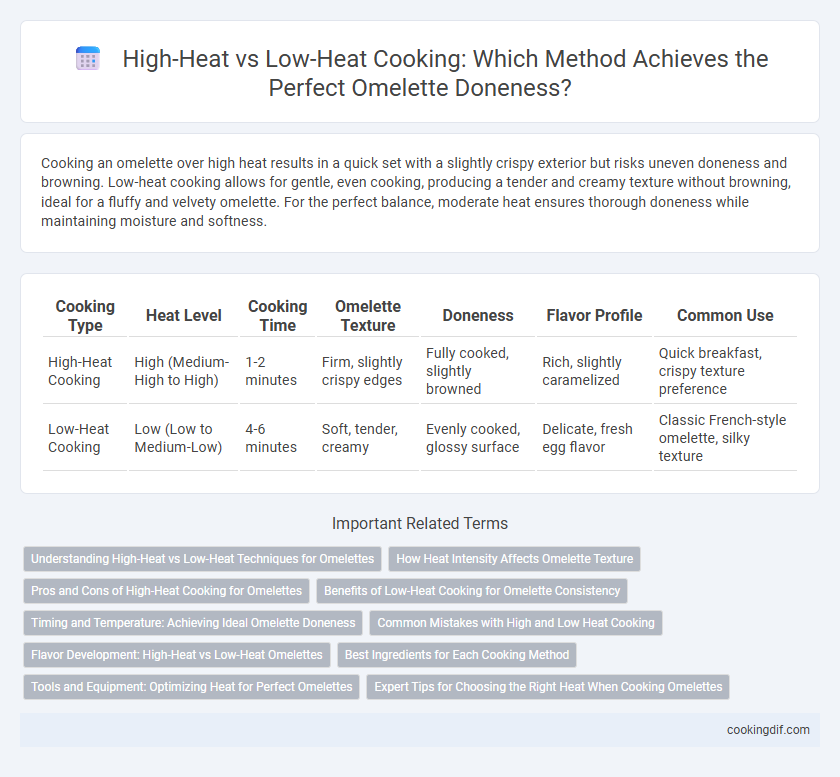Cooking an omelette over high heat results in a quick set with a slightly crispy exterior but risks uneven doneness and browning. Low-heat cooking allows for gentle, even cooking, producing a tender and creamy texture without browning, ideal for a fluffy and velvety omelette. For the perfect balance, moderate heat ensures thorough doneness while maintaining moisture and softness.
Table of Comparison
| Cooking Type | Heat Level | Cooking Time | Omelette Texture | Doneness | Flavor Profile | Common Use |
|---|---|---|---|---|---|---|
| High-Heat Cooking | High (Medium-High to High) | 1-2 minutes | Firm, slightly crispy edges | Fully cooked, slightly browned | Rich, slightly caramelized | Quick breakfast, crispy texture preference |
| Low-Heat Cooking | Low (Low to Medium-Low) | 4-6 minutes | Soft, tender, creamy | Evenly cooked, glossy surface | Delicate, fresh egg flavor | Classic French-style omelette, silky texture |
Understanding High-Heat vs Low-Heat Techniques for Omelettes
High-heat cooking for omelettes results in rapid egg coagulation, producing a slightly browned exterior but risking a rubbery texture if overcooked. Low-heat techniques allow for gentle, even cooking that maintains a creamy, tender interior and prevents browning, essential for classic French-style omelettes. Mastering the balance between heat intensity and timing ensures optimal doneness and texture tailored to personal preference.
How Heat Intensity Affects Omelette Texture
High-heat cooking results in a firm, browned omelette exterior but may cause uneven doneness and a rubbery texture, as proteins rapidly coagulate and moisture evaporates quickly. Low-heat cooking allows gentle protein coagulation, producing a tender, creamy texture with consistent doneness throughout the omelette. Controlling heat intensity is crucial for achieving the desired balance between fluffiness and structural integrity in an omelette.
Pros and Cons of High-Heat Cooking for Omelettes
High-heat cooking for omelettes results in a rapid set and slight browning that enhances flavor through Maillard reactions but risks uneven cooking and a dry, rubbery texture. This method is ideal for achieving a crispy exterior quickly but offers less control over the interior doneness, often leading to overcooked eggs. While it saves time, the high temperature demands constant attention to prevent burning and preserves fewer delicate nutrients compared to low-heat cooking.
Benefits of Low-Heat Cooking for Omelette Consistency
Low-heat cooking allows for even heat distribution, resulting in a tender and creamy omelette without browning or rubberiness. This method preserves the eggs' moisture, creating a smooth, custard-like texture that enhances flavor and mouthfeel. Consistent low heat minimizes the risk of overcooking, ensuring every bite remains soft and delicate.
Timing and Temperature: Achieving Ideal Omelette Doneness
Cooking an omelette over medium-low heat at around 250degF (120degC) ensures even cooking and a tender, creamy texture by allowing the eggs to set slowly without browning. High-heat cooking above 350degF (175degC) risks overcooking the outer layers while leaving the inside runny or dry, compromising ideal doneness. Precise timing, typically 2-3 minutes for medium-low heat, is crucial to achieve a perfectly cooked omelette with a soft, custardy interior and lightly set surface.
Common Mistakes with High and Low Heat Cooking
High-heat cooking often leads to burnt edges and an unevenly cooked omelette, while low-heat cooking may result in a rubbery texture and excessive moisture retention. Common mistakes include neglecting to adjust heat settings promptly, causing overcooked or undercooked sections. Achieving the perfect omelette requires controlling heat to ensure a tender, evenly cooked interior without browning or sogginess.
Flavor Development: High-Heat vs Low-Heat Omelettes
High-heat cooking of omelettes promotes Maillard reactions, creating a richer, caramelized flavor profile with a slightly crispy texture. Low-heat cooking allows for gentle coagulation of eggs, preserving a creamy, tender interior with subtle, natural egg flavors. Choosing between high-heat and low-heat methods impacts the balance between complex, savory notes and smooth, delicate taste in the final omelette.
Best Ingredients for Each Cooking Method
High-heat cooking for omelettes requires ingredients with quick cooking times like thinly sliced vegetables, soft cheeses such as goat cheese or feta, and pre-cooked meats to ensure even doneness without burning. Low-heat cooking suits delicate ingredients like fresh herbs, creamy cheeses like ricotta or cream cheese, and raw vegetables that benefit from gentle cooking to maintain texture and flavor. Choosing ingredients that match the cooking temperature maximizes the omelette's taste and texture, preventing overcooking or undercooking.
Tools and Equipment: Optimizing Heat for Perfect Omelettes
Using a non-stick skillet with precise temperature control enhances omelette doneness by preventing uneven heat distribution common in high-heat cooking. Low-heat cooking benefits from utensils like silicone spatulas, which allow gentle folding and even cooking, reducing the risk of browning or burning. Investing in an induction cooktop or a stovetop with adjustable heat settings provides optimal temperature management for fluffy, well-cooked omelettes.
Expert Tips for Choosing the Right Heat When Cooking Omelettes
Cooking omelettes over medium-low heat ensures even cooking and a tender, creamy texture, preventing browning or rubberiness. High heat may produce a browned, crispy exterior, but risks overcooking the interior and losing moisture. Experts recommend controlling the stove temperature precisely, using non-stick pans, and gently stirring the eggs for optimal doneness and consistency.
High-heat cooking vs low-heat cooking for omelette doneness Infographic

 cookingdif.com
cookingdif.com